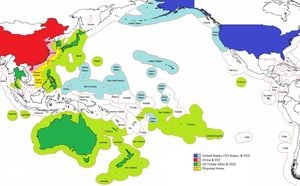The global economic stage is witnessing significant shifts, particularly highlighted by the rising prominence of India and its ties with other nations. At the heart of this transformation is the burgeoning BRICS+ group, which includes Brazil, Russia, India, China, South Africa, and recently expanded to encompass Egypt, Ethiopia, Iran, Saudi Arabia, and the UAE. According to EY India, this coalition is on track to outpace the G7 economies—comprising the United States, Canada, France, Germany, Italy, Japan, and the United Kingdom—in terms of global merchandise exports by 2026. The trends articulated within the October issue of EY Economy Watch reveal the BRICS+ group has dramatically increased its share of global exports from 10.7% to 23.3% between 2000 and 2023, climbing impressively by 12.6 percentage points. Meanwhile, the G7's share has plummeted from 45.1% to just 28.9%, signaling a major recalibration of global trade dynamics.
This seismic shift reflects more than just numbers; it heralds the ascendance of developing economies on the global stage, advocating for what analysts term a 'multipolar' economic structure. D.K. Srivastava, Chief Policy Advisor at EY India, predicts, "Given the present trends and the likelihood of several new members joining the BRICS+ group being strong, the share of BRICS+ can overtake the G7 group by 2026." Such insights suggest significant impending changes, driven largely by economic juggernauts like China and India, which ranked first and third globally, respectively, by purchasing power parity as of 2023 and are likely to retain such standings until 2030.
The influence of these two nations is magnified through their export contributions. China’s share of BRICS+ exports surged from 36.1% to 62.5% over the last two decades, whereas India accounted for 7.9% by 2023. This impressive increase is complemented by the rising importance of high-tech exports from BRICS+, now owning 32.8% of the global share, up from only 5% back in 2000. This transition not only emphasizes the region’s capabilities but also its ambitions to become key players within the high-tech market globally.
Further embedding its role within this international framework, India is also striving to amplify its regional influence through strategic partnerships and developments, including its engagements with Bhutan. Recently, Bhutan's Prime Minister Tshering Tobgay elaborated on the ambitious 'Mindfulness City' project during the NDTV World Summit, emphasizing the inherent links between Bhutan's future and its relationship with India. The initiative aims to create a sustainable urban hub near the India-Bhutan border, cementing the countries’ collaborative spirit. According to Tobgay, "Our future is linked with India," reflecting the deep-seated ties and mutual aspirations between the nations.
Investment discussions surrounding this project are gaining traction, particularly with Indian firms like the Adani Group analyzing potential infrastructure developments within the project scope. The Mindfulness City will strive to balance nature and urban living, guided by Bhutan's commitment to 'Gross National Happiness 2.0', which promotes happiness through sustainable living. The city is set to encompass protected areas, forests, and biological corridors, touting Bhutan’s dedication to ecological sustainability.
Despite these positive shifts, challenges remain, particularly as India navigates its oil import strategies. Recent reports revealed India’s crude oil imports fell by 10% to 4.24 million barrels per day (mbpd) in October 2024, reflecting strategic market adjustments. Notably, its imports from Russia saw a significant decline as Indian refiners shifted focus back to traditional suppliers from West Asia, partially attributed to strengthened demand from Chinese buyers and diminishing discounts previously offered by Russia. Before the Russia-Ukraine conflict, India’s reliance on Russian crude was minimal at less than 0.2% but skyrocketed post-conflict to about 40% as Indian refineries sought significant deals. Now, the diminishing price advantages from Russia are prompting re-evaluation among Indian refiners, which are tapping back to Middle Eastern suppliers.
These developments signal India's adaptability and strategic positioning within the global energy markets. Industry experts expect Indian refineries to ramp up imports next quarter to meet increased domestic demands driven by seasonal consumption spikes during festive periods. Serena Huang, Head of APAC Analysis at Vortexa, noted, "With domestic demand expected to rise due to festive seasons in Q4, refiners will likely be ramping up crude runs and imports next month.” Such insights reveal the continuous dance between market dynamics, geopolitical factors, and regional energy security.
This backdrop of economic intricacies forms the foundation of India's decentralized yet expansive approach on the global trade stage. The increasing momentum of BRICS+, the ambitious infrastructure projects within Bhutan, and the nuanced shifts within India’s oil imports vividly reflect how the narrative of international trade and economic power is continually being rewritten. With these developments, India is asserting its role not just as part of the BRICS+ group but as a bridge fostering connectiveness and growth across borders.



